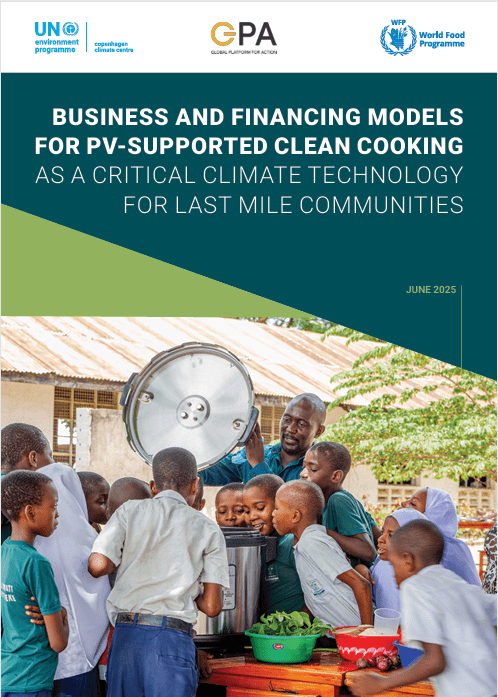Business and financing models for PV-supported clean cooking as a critical technology for last mile communities
 |
report Jun 2025 ; 26 pages
Aut. James Haselip & Iwona Bisaga & Raffaella Bellanca & Feisal Hussain
Ed. Global Platform for Action - Genève UNEP - Nairobi WFP - Roma
Downloadable format: PdF
Downloadable from the publisher
Résumé:
L'adoption de solutions de cuisson propre avancées (niveau 4+), surtout dans les communautés isolées, reste un besoin essentiel mais souvent sous-financé. Des technologies comme la cuisson électrique solaire (eCooking), les foyers à biomasse soutenus par le photovoltaïque et les cuisinières à éthanol existent, mais font face à des obstacles tels que des coûts initiaux élevés et une faible sensibilisation des utilisateurs. Cependant, la baisse des prix des panneaux solaires et l’accessibilité accrue des appareils soutenus par le photovoltaïque rendent ces solutions plus rentables et mieux alignées avec les objectifs climatiques nationaux (CDN).
La cuisson soutenue par le photovoltaïque réduit les émissions de CO₂ et d'autres polluants en diminuant la dépendance à la biomasse non durable, contribuant ainsi à l'atténuation et à l'adaptation au changement climatique. Le déploiement à grande échelle de ces solutions peut combler le fossé des émissions et faire avancer les Objectifs de Développement Durable (ODD).
Surmonter les obstacles nécessite des actions à la fois du côté de l'offre et de la demande, y compris des financements abordables et des solutions basées sur le marché.
Ce rapport est co-publié avec le Programme Alimentaire Mondial (PAM) et la Plateforme Mondiale pour l'Action en faveur de l'Énergie Durable dans les Contextes de Déplacement (GPA), en soutien à la Coalition Mondiale pour la Cuisson Électrique (GeCCo) et au Partenariat pour la Cuisson Électrique Solaire (SOLCO). Abstract:
The adoption of advanced clean cooking solutions (tier 4+), especially in remote communities, remains a critical but often underfunded need. Technologies like solar-powered electric cooking (eCooking), PV-supported biomass stoves, and ethanol stoves exist, but face barriers like high upfront costs and low user awareness. However, falling solar PV prices and more affordable PV-supported appliances are making these solutions more cost-effective and aligned with national climate goals (NDCs).
PV-supported cooking reduces CO2 and other emissions by lowering dependence on unsustainable biomass, helping both climate mitigation and adaptation. Scaling these solutions can close the Emissions Gap and advance Sustainable Development Goals (SDGs).
Overcoming adoption barriers needs both supply and demand-side actions, including affordable financing and market-based solutions.
This report is co-published with the World Food Programme (WFP) and the Global Platform for Action on Sustainable Energy in Displacement Settings (GPA), supporting the Global electric Cooking Coalition (GeCCo) and the Solar electric Cooking Partnership (SOLCO). Contents:
1. INTRODUCTION ............................................................................................5
2. FINANCING AND BUSINESS MODELS TO GROW THE MARKET FOR PV-SUPPORTED CLEAN COOKING ......................................................7
2.1 Blended finance ............................................................................................................................................................10
2.2 Results-based financing (RBF) ..................................................................................................................................12
2.3 Peer-to-peer lending (P2P) .........................................................................................................................................13
2.4 Carbon and outcome-based finance ........................................................................................................................14
2.5 De-risking carbon financing for clean cooking at scale .........................................................................................15
2.6 Pay as You Go (PAYGO) business models ...............................................................................................................16
2.7 The use of digital financial solutions .........................................................................................................................18
2.8 Innovative fiscal policies ..............................................................................................................................................19
2.9 Conclusions ....................................................................................................................................................................19
3. UNDERSTANDING SOLAR-POWERED COOKING TECHNOLOGIES: A SOLCO PARTNERSHIP OVERVIEW ..........................................................20
REFERENCES ....................................................................................................................................................24
LINKS TO FURTHER READING, ARTICLES AND WEBINARS ............................................................................25
Target Audience:
Keywords: |
heat - cooking (CI) (DT) (ET) (ope) , rural (CI) (DT) (ET) (ope) , solar energy (CI) (DT) (ET) (ope) |
Publishers/Broadcasters: |
|
Global Platform for Action - Genève - Switzerland |
UNEP
-
United Nations Environment Programme - Nairobi - Kenya |
WFP
-
World Food Programme - Roma - Italy |
If there is a broken link, we will be pleased to receive a message: communication@pseau.org